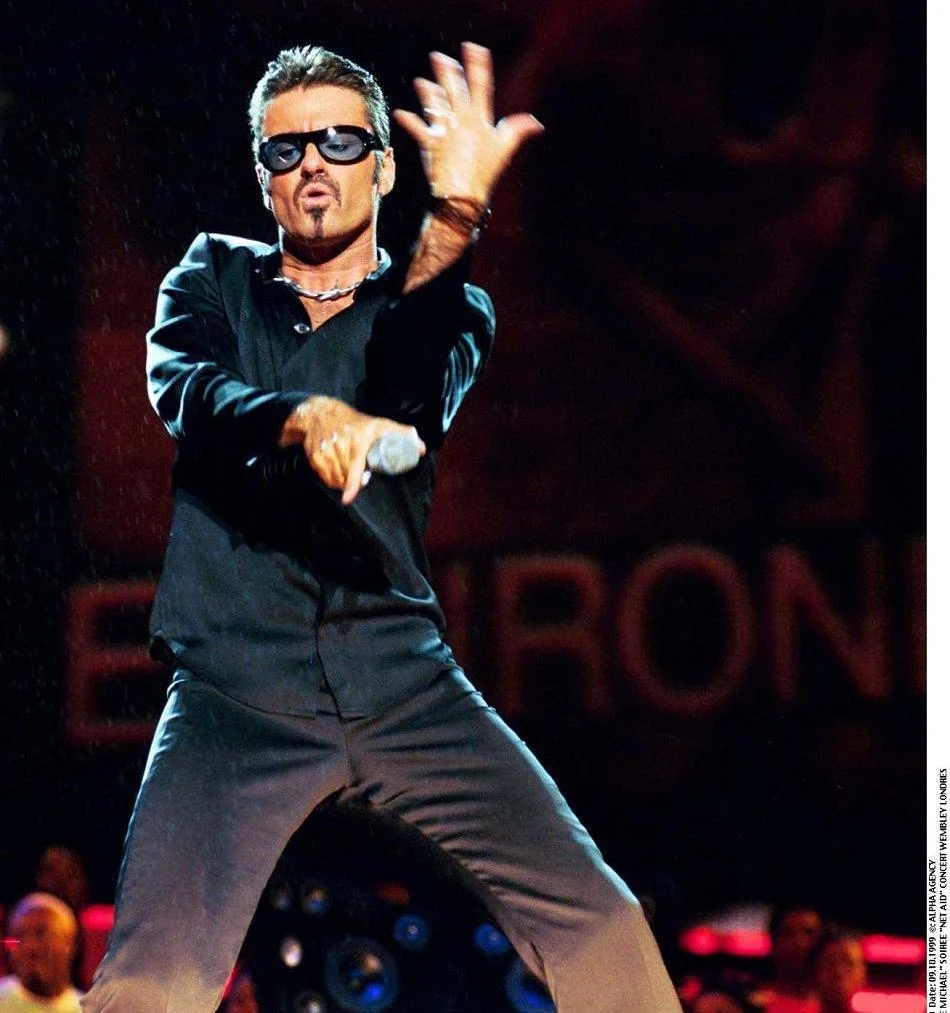George Michael’s fourth studio album, “Songs from the Last Century,” released in 1999, stands as a poignant and reflective work within his illustrious discography. Diverging markedly from his previous albums, this record does not showcase original material but is a collection of cover songs, each meticulously chosen to form a cohesive narrative through the 20th-century musical landscape. This album arrives as a thoughtful interlude, nestled between the personal revelations of “Older” (1996) and the reflective “Patience” (2004), offering a moment of introspection through the reinterpretation of classics.
Artistic Intentions
The album represents a significant departure from Michael’s usual pop and dance-driven fare, leaning instead into a more subdued, jazz-infused style. This shift can be seen as both an homage to the musical giants of the past and an exploration of Michael’s versatility as a vocalist and interpreter. “Songs from the Last Century” functions as a historical tapestry, threading through genres and eras, from the swinging sensibilities of Frank Sinatra to the introspective lyricism of Sting.
Artistically, Michael aimed to connect with the roots of modern music, demonstrating his respect and deep appreciation for the foundational works that influenced countless artists, including himself. In interviews around the release, Michael spoke of the album as a personal challenge to step outside his creative comfort zone and engage with music that had shaped his own artistic identity. This project was also a way for him to showcase his vocal prowess in a more stripped-down, intimate setting, diverging from the high-production pop sound he was known for.
Sonic Exploration

The production on “Songs from the Last Century” is characterized by its clarity and sophistication, a testament to the meticulous work of producer Phil Ramone, known for his work with artists like Billy Joel and Paul Simon. The production choices serve to enhance the timeless quality of the tracks, employing a high-fidelity sound that respects the original compositions while presenting them through a contemporary lens. This approach allows George Michael’s voice to resonate with warmth and authenticity, enveloping the listener in a sound that is both crisp and enveloping. The use of traditional recording techniques, combined with modern clarity, ensures that each song retains a soulful, classic feel without feeling dated, aligning perfectly with the album’s reflective theme.
Musical Arrangements
The arrangements on the album are a deft blend of simplicity and elegance, allowing the strength of the vocals to shine through while being supported by rich, textured backgrounds. Notably, the orchestral arrangement in “Brother, Can You Spare a Dime?” adds a dramatic, almost cinematic quality that amplifies the song’s poignant themes. Similarly, the sparse, piano-driven arrangement of “Roxanne” strips the song down to its emotional core, highlighting Michael’s ability to convey deep vulnerability through his voice. These choices in arrangement not only pay homage to the era and style of each piece but also bring a fresh perspective through subtle innovations and nuanced interpretations.
Genre Elements
George Michael navigates through a variety of genres in “Songs from the Last Century,” touching upon jazz, blues, big band, and pop. Each song is carefully chosen and reimagined to reflect both the essence of the original and Michael’s unique interpretative style. The album does not so much blend genres into a single cohesive style but rather showcases a spectrum of distinct styles, each treated with respect and artistic integrity. This approach allows the album to serve as a musical tour through the last century, with Michael acting as both guide and interpreter. The genre explorations are faithful yet refreshing, offering listeners a journey through familiar landscapes seen through new eyes.
Lyrical Analysis

“Songs from the Last Century” showcases a thoughtful selection of tracks that speak to universal human experiences—love, loss, hope, and despair. This array of themes is brought forth through lyrical narratives that traverse time and emotion. For instance, the contemplative sorrow in “Brother, Can You Spare a Dime?” illustrates the desperation and loss of dignity during the Great Depression, contrasting sharply with the more introspective and tender lyrics of “The First Time Ever I Saw Your Face.” Each song, while distinct in its storytelling, contributes to an overarching narrative about the human condition, reflecting on how these emotions have been expressed through different musical eras.
Lyrical Depth
The lyrics across the album vary from the straightforward and narrative to the deeply metaphorical, offering layers of meaning that invite personal interpretation. “Roxanne,” originally by The Police, is reinterpreted with a jazz-infused style that shifts the focus from its pop roots to a more somber, reflective mood, highlighting the song’s narrative about love and redemption. Similarly, “I Remember You,” rendered with a gentle, nostalgic air, showcases the subtlety and poetic grace of the lyrics, evoking a sense of longing and remembrance that is both specific and universal. The album’s choice of songs demonstrates a deep appreciation for lyrical craftsmanship, choosing pieces that not only stand the test of time but also resonate with emotional depth and complexity.
Emotional Impact
The emotional impact of the lyrics is profound, as George Michael’s interpretations imbue each song with a fresh emotional palette that aligns with his vocal expressions. The melancholy infused in “You’ve Changed” is palpable, conveying a sense of personal loss and transformation that is almost tangible. The emotive power of “My Baby Just Cares for Me” contrasts this with a lighter, more playful tone, reflecting joy and adoration in a way that lifts the spirit. Each track, through its lyrics, complements the album’s sonic landscape, enhancing the emotional resonance and inviting listeners into a reflective, often introspective journey.
Cohesion and Flow

The flow of tracks in “Songs from the Last Century” is carefully curated to take the listener on a seamless journey through different eras and styles, while maintaining a clear emotional and narrative progression. The album opens with “Brother, Can You Spare a Dime?” setting a tone of reflective depth and historical resonance, which gradually unfolds into more personal and introspective themes as the album progresses. The transition from the haunting “My Baby Just Cares for Me” to the more somber “Roxanne” demonstrates George Michael’s skill in sequencing songs in a way that feels like a natural evolution of mood and story. Each track is placed to build upon the last, ensuring a smooth emotional trajectory that guides the listener through varying shades of sentiment and introspection, culminating in the poignant “I Remember You,” which serves as a tender, nostalgic close to the album.
Thematic Consistency
Throughout “Songs from the Last Century,” the themes of love, loss, and existential reflection are threaded with remarkable consistency, despite the diversity of song choices and genres. This thematic cohesion is achieved through the emotional integrity and stylistic maturity that George Michael brings to each interpretation. The stylistic shifts between jazz, blues, and traditional pop are handled with finesse, ensuring that each song complements the next without causing abrupt disruptions to the album’s overall mood.
Even with its rich variety of musical styles, the album maintains a coherent artistic vision, marked by an underlying melancholy and reflective quality that binds the songs together. This consistency allows for a listening experience that feels unified and intentional, rather than a mere compilation of disparate tracks. The emotional and thematic through-lines are clear and potent, making the album not just a collection of covers but a profound exploration of the human experience across time.
Standout Tracks and Moments

Among the diverse tapestry of songs on “Songs from the Last Century,” certain tracks stand out for their unique interpretation and profound emotional resonance. “Roxanne,” originally a rock hit by The Police, is transformed under George Michael’s touch into a slow, jazz-infused ballad that strips the song down to its emotional core. His ability to reinterpret this well-known track into something entirely new and soulful showcases his artistic merit and vocal prowess.
Another standout is “Brother, Can You Spare a Dime?” which is arguably one of the album’s most powerful pieces. Its placement as the opening track sets a reflective and somewhat somber tone for the album. Michael’s delivery of the song’s poignant lyrics, which narrate the despair of the Great Depression, is both moving and evocative, highlighting his ability to convey deep emotions through music.
Memorable Moments
The album is punctuated with moments that capture its essence and showcase George Michael’s talents. One such moment occurs in “My Baby Just Cares for Me,” where Michael’s vocal stylings play with the melody in a way that adds a fresh twist to this classic, reflecting his playful side and deep understanding of vocal dynamics. The light-heartedness of this track provides a brief respite from the more somber songs, illustrating the album’s emotional range.
Another memorable moment is found in the cover of “The First Time Ever I Saw Your Face.” The lingering, almost ethereal delivery of the lyrics, paired with minimalistic instrumentation, allows Michael’s voice to soar, creating a powerful emotional buildup that is both intimate and overwhelming. This track serves as a showcase not only for his vocal ability but also for his capacity to interpret and embody the song’s deep emotional themes.
The instrumental break in “Secret Love,” where a soft saxophone interlude complements Michael’s vocals, offers a poignant reminder of the album’s jazz influences and its seamless integration of different musical elements. This break not only enhances the song’s romantic atmosphere but also emphasizes the album’s overall mood of reflective nostalgia.
In summary, “Songs from the Last Century” is punctuated by tracks and moments that exemplify George Michael’s artistic vision and his exceptional ability to connect with the music and the listener on a deep, emotional level. These highlights not only underscore his versatility as an artist but also affirm the album’s significance as a heartfelt homage to the musical past.
Artistic Contribution and Innovation

“Songs from the Last Century” occupies a unique place in both George Michael’s discography and the broader music industry. This album, comprising entirely of covers, diverges from the typical commercial path often trodden by contemporary pop artists. Instead of pursuing further chart-topping hits, Michael opted for a project that allowed him to explore and pay homage to the musical foundations laid by previous generations. In doing so, he not only reaffirmed his role as a versatile and skilled musician but also contributed to a deeper appreciation of classic songs within the modern music scene. The album adheres to established norms in terms of its respectful approach to each cover but pushes boundaries by recontextualizing these classics in a way that resonated with contemporary audiences, bridging a gap between eras.
Innovation
The innovative nature of “Songs from the Last Century” lies in its approach to the genre and production. The choice of Phil Ramone as producer—a figure known for his work with legendary artists in more acoustic and jazz-oriented settings—was a deliberate one that influenced the album’s refined sound. Ramone’s production expertise ensured that the classic elements of each song were preserved while being infused with modern, high-quality soundscapes that appeal to listeners of the time.
In terms of genre, George Michael’s selection of songs covers a wide spectrum, from jazz and blues to popular ballads. His ability to navigate these genres, often blending elements from one into another, showcases a form of musical innovation that respects traditional boundaries yet also explores the interconnections between them. This not only highlights his musical versatility but also offers a fresh take on well-worn paths.
Thematically, the album’s exploration of timeless human emotions through the lens of such a diverse range of songs was itself an innovation. Michael’s interpretation brings new depth to these classics, prompting listeners to engage with familiar lyrics in new and often more profound ways. His vocal performance, nuanced and emotive, adds layers of meaning to each track, turning what could have been a straightforward cover album into a deep, reflective exploration of the last century’s musical heritage.
Closing Thoughts

“Songs from the Last Century” is a compelling demonstration of George Michael’s vocal talent and his deep reverence for the musical greats of the past. One of the album’s major strengths lies in its sophisticated production and the careful curation of songs, which highlights Michael’s versatility as an artist capable of crossing genres and epochs with ease. The emotional depth and the polished, minimalist arrangements allow for a fresh interpretation of classic tracks, making old songs resonate anew with modern audiences.
However, the album is not without its weaknesses. Its departure from original material to a collection of covers may not satisfy all listeners, particularly those who prefer Michael’s original compositions and dynamic pop sensibilities. Additionally, the uniformity in tempo and mood across the album, while contributing to its cohesiveness, might be perceived as monotonous to some, lacking the varied dynamics that typically mark more commercially successful albums.
Final Thoughts and Rating
“Songs from the Last Century” serves as a poignant chapter in George Michael’s career, emphasizing his artistic maturity and his ability to engage with music on a deeply personal level. This album may not have the commercial appeal of his pop hits, but it offers something arguably more lasting: a bridge between generations of music lovers and a renewed appreciation for the classics.
With its thoughtful production and emotive delivery, the album stands as a testament to Michael’s musical prowess and his respect for the art form. However, given its niche appeal and the slight monotony in its execution, a rating of 7 out of 10 feels appropriate. This score reflects the album’s quality and the exquisite craftsmanship involved, yet acknowledges its limited appeal in comparison to more vibrant and varied works in his discography.
